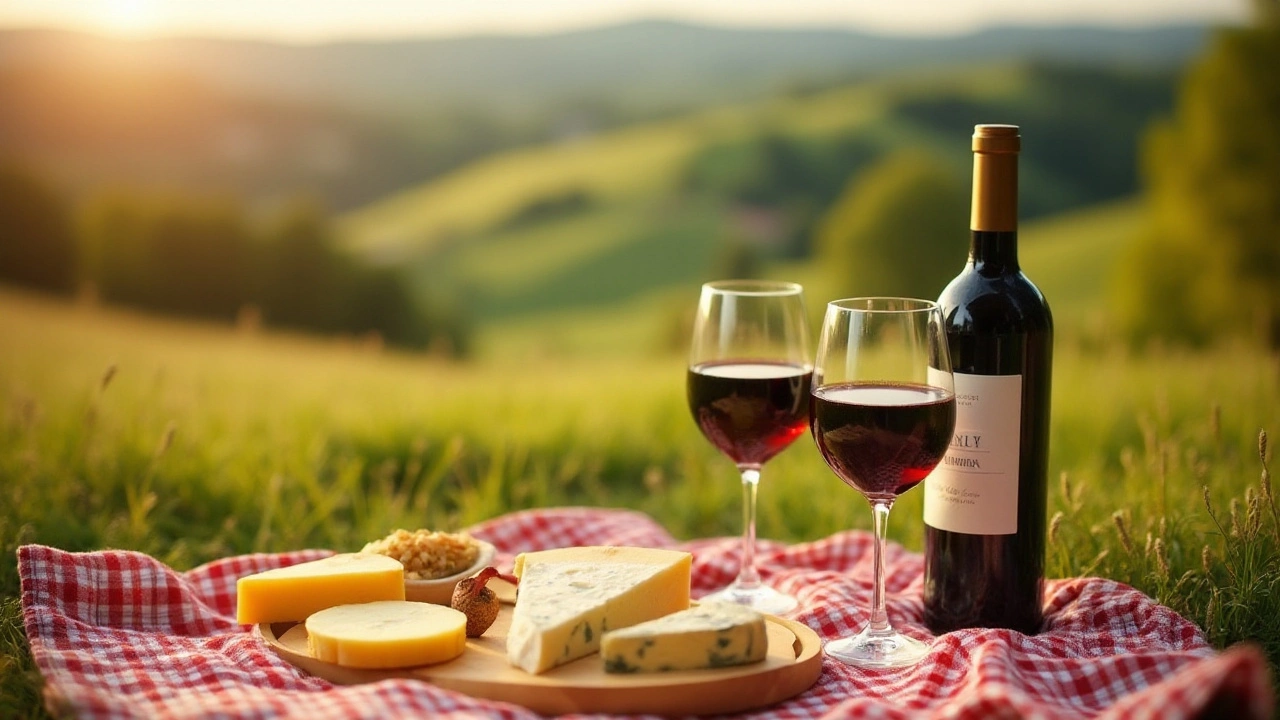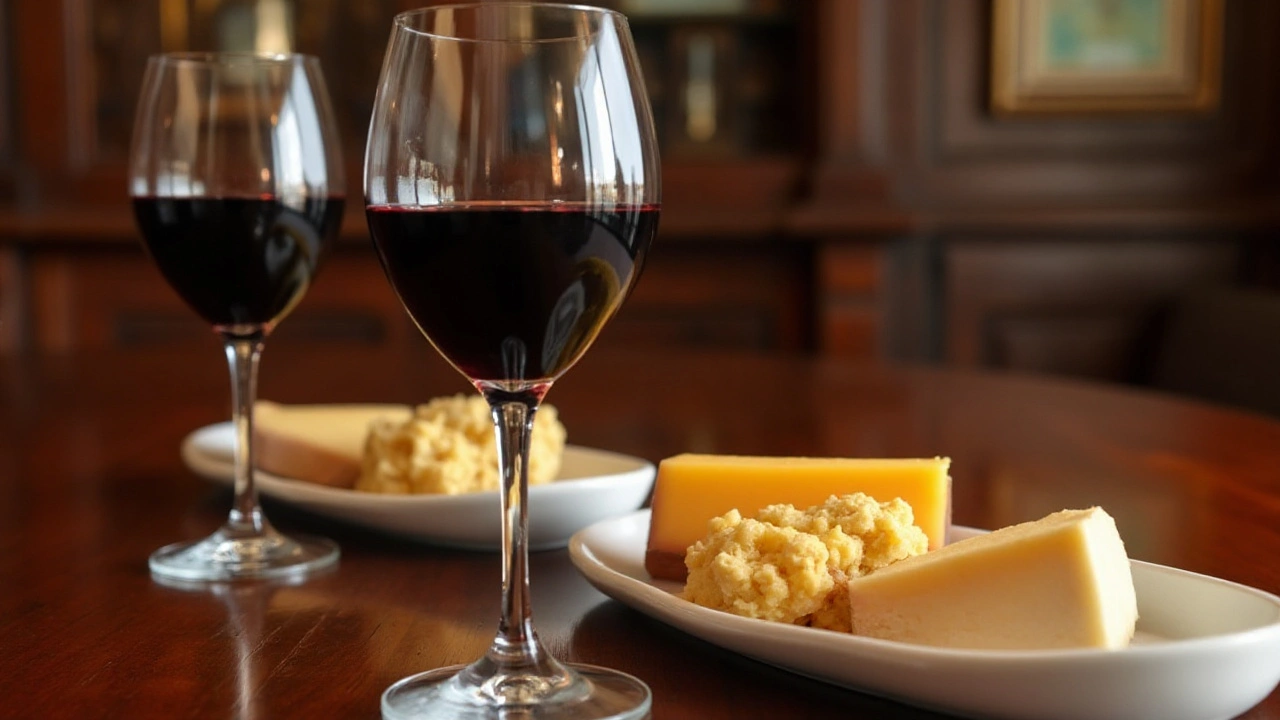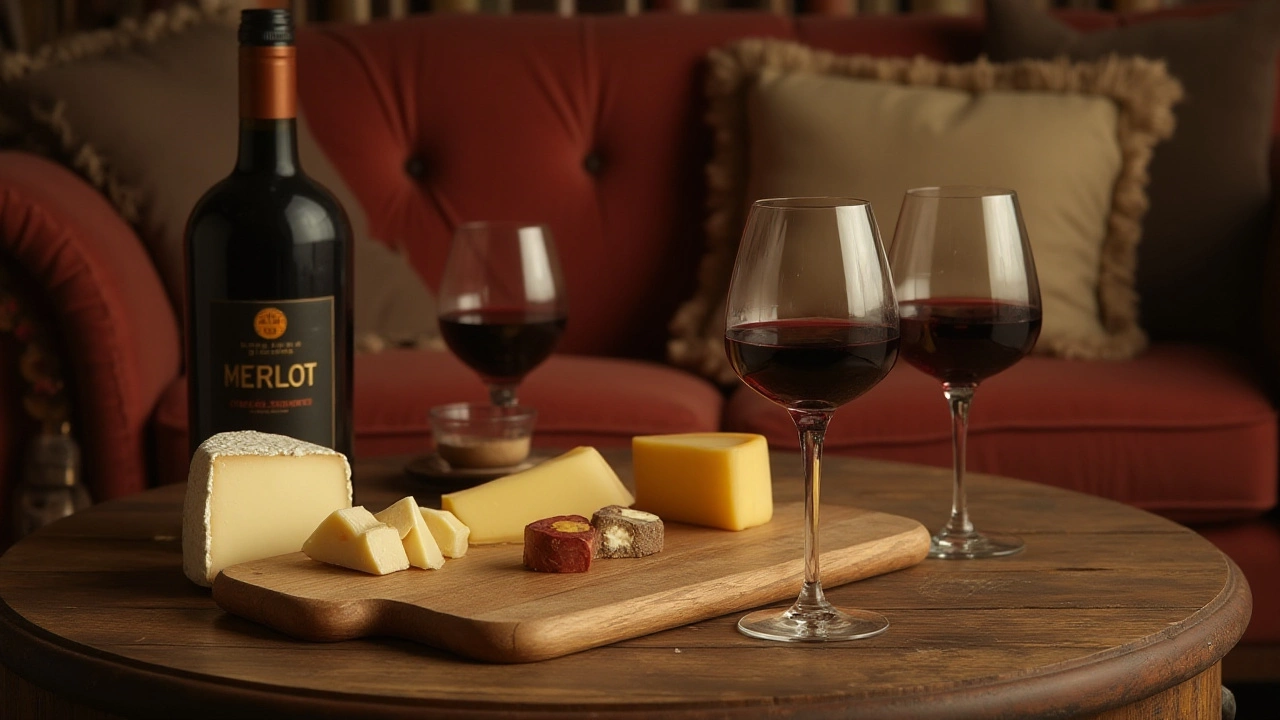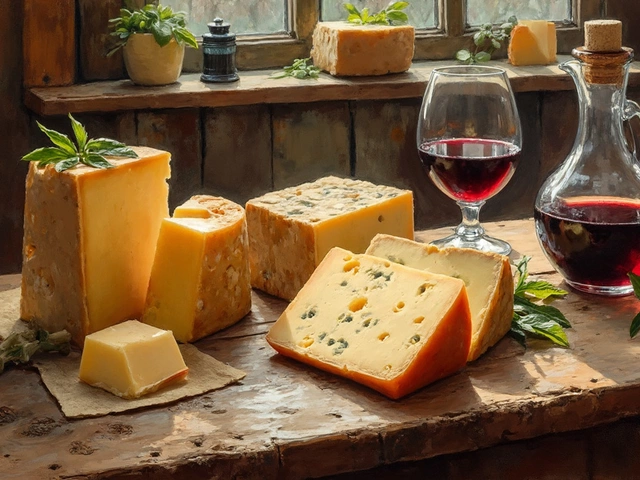Wine and cheese are a classic combination that can transcend ordinary dining into a delightful sensory adventure. Both Merlot and Cabernet Sauvignon are popular choices for wine lovers, each boasting distinct flavors that can be highlighted with the right cheese. While selecting a cheese might seem overwhelming given the myriad of options available, understanding the nuances of these wines can make the process much more enjoyable.
Merlot tends to have a softer, fruitier profile, often exhibiting flavors of plum and black cherry with hints of chocolate or cedar. In contrast, Cabernet Sauvignon is usually more robust and structured, known for its notes of blackcurrant, green pepper, and oak. By choosing cheeses that compliment these characteristics, you can enhance the experience of both the wine and the cheese.
Creating a perfect cheese board for your Merlot or Cabernet Sauvignon isn’t just about selecting any cheese; it’s an art that can transform your evening. Whether you prefer a creamy brie with your Merlot or a sharp cheddar with your Cabernet Sauvignon, the key is in balancing flavors. Let’s dive into pairing wisdom that might just make your next gathering unforgettable.
- Understanding Merlot and Cabernet Sauvignon
- Classic Cheese Pairings for Merlot
- Cheese Choices for Cabernet Sauvignon
- Tips for Pairing Wine and Cheese
- Creating a Memorable Tasting Experience
Understanding Merlot and Cabernet Sauvignon
For wine enthusiasts, Merlot and Cabernet Sauvignon hold a prestigious place in the hierarchy of red wines. Both originating from the Bordeaux region of France, these two varietals have become global staples, each offering distinctive characteristics that captivate palates all over the world and often making the perfect companions to cheese pairing. Merlot is typically described as soft and supple, known for its lush fruit-forward profile with flavors of ripe plum, cherry, and blackberry. Cabernet Sauvignon, on the other hand, is more robust and full-bodied, often showcasing a mix of blackcurrant, green pepper, mint, and tobacco notes, thanks to its thicker skin and natural tannins.
The history of Merlot begins around the 1700s, its name thought to have derived from the blackbird, or 'merle' in French, likely due to the grape’s blue hue. It's renowned for its approachability, often being the entry point for new red wine drinkers. In contrast, Cabernet Sauvignon emerged only in the 17th century, a fascinating cross between Cabernet Franc and Sauvignon Blanc. Its ability to age gracefully, developing complex layers over time, makes it a favorite for wine collectors worldwide.
An interesting aspect to note is the influence of terroir—Cabernet Sauvignon tends to show varying expressions depending on where it’s grown. A California Cab can differ significantly from a French or Chilean version, each offering unique traits. Unlike Merlot, which often highlights plush and velvety textures, a Cabernet’s appeal lies in its structure and complexity, with tannins that provide a unique drying sensation on the palate. When considering pairings, these traits are integral because they inform which flavors and textures of cheese would best complement each wine.
An old saying in the wine world, from the late French gastronomy giant Brillat-Savarin, goes as
"Tell me what you eat, and I will tell you what you are."This is particularly relevant when pairing these wines with cheese, as understanding their unique flavor profiles is crucial in selecting the right cheese to enhance their individual characteristics.
Classic Cheese Pairings for Merlot
Exploring the intricate pairing of cheese with Merlot unlocks a world of flavors that can both satisfy and surprise the senses. Merlot, with its lush, velvety texture, offers a mild tannin profile, making it an excellent companion for a variety of cheeses. The wine’s berry-infused notes challenge cheese enthusiasts to find a balance that either contrasts or complements its fruitiness.
One popular pairing is with Brie, a soft cheese celebrated for its creamy, buttery character. The gentle nutty undertones of Brie can accentuate Merlot's plum nuances, creating a luxurious taste experience. This pairing has been particularly favored for its seamless blend of textures; the creaminess of Brie juxtaposes perfectly with Merlot’s smooth finish. Saint-André, a triple-creme cheese from France, is another choice that adds depth with its rich, buttery layer, often likened to a silkier Brie. This delightful match grows in eloquence as the cheese’s subtle tang lifts the fruitiness of the wine.
Going Beyond the Ordinary
If you wish to delve beyond Brie, aged Gouda offers a rewarding alternative. The cheese brings a caramel-like flavor to the table, complementing the undertones of black cherry in Merlot. After spending time aging, Gouda develops a crystalline texture, offering a mosaic of sweet and tangy flavors. Pairing aged Gouda with Merlot elegantly augments the wine’s complexity. A firm English cheese like Red Leicester, known for its earthy sweetness, also stands as a great contender. Its crumbly yet robust consistency highlights Merlot’s subtle earthy tones, producing an intriguing blend.For those who lean towards a cheese with more assertive flavors, Gruyère provides an enticing option. This Swiss cheese has a nutty and slightly salty palette that doesn’t overpower but rather enhances the more rustic elements of Merlot. Its depth evolves with each bite, matching Merlot's layered personality. This pairing is frequently recommended by sommeliers for those hosting a variety of guests, as it bridges diverse flavor preferences.
“A problem with pairing is people often overthink. Let the wine and cheese naturally enhance each other.” — Renowned sommelier, Anna-Marie Faulkner
Thus, while pairing cheese with Merlot, it's not just about matching flavors but achieving harmony—allowing the mild acidity and floral notes of *Merlot* to dance with the creamy or aged profiles of your chosen cheese. Whether you decide on a rare artisanal cheese or stick with time-tested classics, the intent is to curate an experience that resonates with your palate.

Cheese Choices for Cabernet Sauvignon
Finding the perfect cheese to pair with a rich, bold Cabernet Sauvignon is about balancing its intensity with complementary flavors and textures. This robust wine, known for its strong tannins and full-bodied character, requires cheeses that can stand up to its power without overwhelming the palate. One of the most celebrated pairings is aged cheddar, which has the sharpness to match the wine's intensity. Aged cheddar, with its crumbly texture and sharp, nutty notes, creates a delightful contrast to the deep berry flavors and oak notes of the wine. The saltiness of the cheese can also help to soften the tannins, making each sip of Cabernet smoother on the palate.
In addition to cheddar, another excellent companion for Cabernet is gouda, especially when it has been aged to reveal its caramel and nutty undertones. The firmness and the slightly sweet savoriness of gouda can highlight the fruitiness in the wine while providing a satisfying mouthfeel. Similarly, blue cheeses like Stilton or Roquefort, with their pungent, creamy profiles, can offer a unique pairing experience. The intense flavors of these blue cheeses can echo the complexity of the wine, while their creamy texture intertwines beautifully with Cabernet’s tannins. It's a partnership that showcases the magic of pairing opposites to create a harmonious taste sensation.
"Wine and cheese pairing is a journey, much like the wine itself. Finding the perfect match is a personal discovery," says renowned sommelier Andrea Robinson. Her insight echoes the sentiment of many who have ventured into the intricate dance of flavor and aroma, understanding that each cheese transforms the experience of the wine.
Merlot may have its fair share of ideal matches, but don't discount the array of cheeses that can beautifully complement a glass of Cabernet Sauvignon. For those who enjoy experimenting, try adding pecorino to the list. This sheep's milk cheese, with its granular texture and distinctively sharp flavor, adds an earthy component that aligns with the herbal notes some Cabernets exhibit. Pecorino's robust salinity also helps to accentuate the wine's fruitier aspects, making it an excellent choice for an all-around balanced pairing.
For a truly indulgent experience, consider serving a cheese board featuring a variety of these selections alongside seasonal fruits, nuts, and artisan bread. The diversity allows guests to discover their preferred combinations, enhancing each bite and sip with new dimensions. When planning a wine and cheese night, these wine and cheese pairings ensure that your Cabernet Sauvignon remains the star of the show, while providing an array of accompaniments that tantalize and intrigue the senses.
Tips for Pairing Wine and Cheese
Pairing wine and cheese successfully is about understanding the harmony between complementary flavors. It’s not just a matter of taste; it’s an art that involves sensory exploration. First, consider the intensity of both the wine and cheese. A robust Cabernet Sauvignon requires a cheese that can stand up to its bold flavors—think aged cheddars or gouda. These cheeses have the depth and maturity to enhance the complex notes of blackcurrant and oak in the wine.
On the other hand, the softer, fruitier qualities of Merlot are best matched with smoother and creamier cheeses, such as brie or Camembert. These cheeses can bring out the lush fruit components and silky texture of the wine, creating a balanced tasting experience. The secret here is to match the weight and texture of the cheese with the body and characteristics of the wine.
Cary Rati, a renowned sommelier, once said, "A perfect pairing is like a dance, where each partner follows the rhythm and balance of the other with ease." This illustrates how the right combination can elevate your palate and create a memorable dining moment.
Another technique is to analyze the acidity levels. A wine with high acidity can cut through rich and creamy cheeses, cleansing your palate between bites and sips. Meanwhile, cheeses with higher acidity, like goat cheese, can animate the fruity and herbal notes in a Merlot. You might want to experiment with a blue cheese with your Cabernet Sauvignon too—while not a traditional choice, it offers a delightful saltiness that contrasts the wine’s more earthy tones.
For the adventurous palate, try doing a taste test with a variety of cheeses and keep notes on which pairings resonate most with your taste buds. Devote time to explore local cheese shops and vineyards. You may be surprised at the regional cheeses that pair wonderfully with wines from the same area, thanks to the "terroir effect," where the environment influences the character of both the wine and the cheese.
Creating a Cheese Board
While pairings are important, presentation can enhance the experience further. Assemble a cheese board that appeals to the senses. Consider textures, shapes, and colors to create a visually appealing spread. Serve a mixture of hard and soft cheeses alongside nuts, fruits, and bread. Not only will these accompaniments offer delightful contrasts in texture, but they can also spark new flavor combinations with your wine selections, offering a holistic gastronomic journey.- Choose three to five types of cheese to avoid overwhelming the palate.
- Arrange cheeses with a mix of textures: soft, semi-soft, hard, and blue.
- Incorporate seasonal fruits or dried fruits for a sweet contrast.
- Place a variety of nuts like almonds or walnuts; their nuttiness can enhance the oak notes in Cabernet Sauvignon.
- Add artisan bread or crackers for a neutral base that won't overpower the main stars, the wine and cheese.
The joy of wine and cheese pairing lies in personalization. As you taste and learn your preferences, remember that the best pairings are often the ones that bring you joy rather than follow strict rules. Trust your palate, enjoy the journey of discovery, and most importantly, savor each sip and bite.

Creating a Memorable Tasting Experience
There's something enchanting about gathering friends and loved ones around a table, weaving stories and laughter over shared sips of Merlot or Cabernet Sauvignon paired with delectable cheeses. Crafting such a moment is an experience in itself, one that's made even richer when thought and care are put into the selection and presentation of both the wine and the cheese. Start by setting the scene—use a wooden board to lay out your cheese selections, complementing the earthy tones of these beloved red wines. Add small cards with the names of each cheese; it not only educates but adds a touch of elegance.
Now, consider an array of textures and flavors. Balance is key when planning your board; combine soft with hard cheeses, and mild with bold flavors. A Merlot, with its soft, velvety notes and hints of plum and chocolate, pairs wonderfully with creamy brie or a mild gouda. Meanwhile, the structured profile of a Cabernet Sauvignon, rich in blackcurrant and oak undertones, can be elevated with the nutty complexity of aged cheddar or the sharpness of blue cheese. However, don’t be afraid to explore beyond the classics—a well-aged Gruyère offers a delightful twist that can stand up to the intensity of these wines.
To truly engage the senses, consider accompanying your wine and cheese pairings with a variety of sides. Serve slices of fresh baguette or crackers to give a neutral base that allows each pairing to shine. Fresh fruits like figs or grapes, as well as the sticky sweetness of dried apricots or dates, can complement the fruit notes in the wines beautifully. Adding a handful of nuts, like almonds or walnuts, provides a pleasant crunch that contrasts the creaminess of cheese. As a delightful finishing touch, include a small bowl of honey or fig jam for an additional layer of flavor that guests can drizzle atop their cheese and bread combinations.
Remember, presentation plays a powerful role in creating a lasting impression. Arrange your cheese selection in a circular pattern, starting from the mildest flavors and moving towards the strongest. This arrangement is an invitation to your guests to taste and explore in a thoughtful, sequential manner. Don’t overwhelm them with too many choices; a selection of four to six cheeses is just right to keep the journey pleasurable yet uncomplicated.
Jancis Robinson, a well-regarded wine critic, once said, "Cheese and wine are ageless companions, like aspirin and aches, or June and moon, or good people and noble ventures." Keep this in mind as you craft your tasting experience, and let the pairing be more than just a feast for the palate, but a moment that lingers sweetly in memory.


